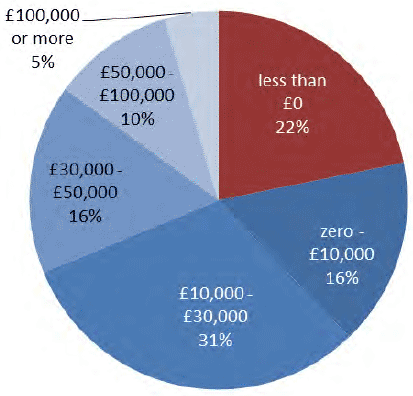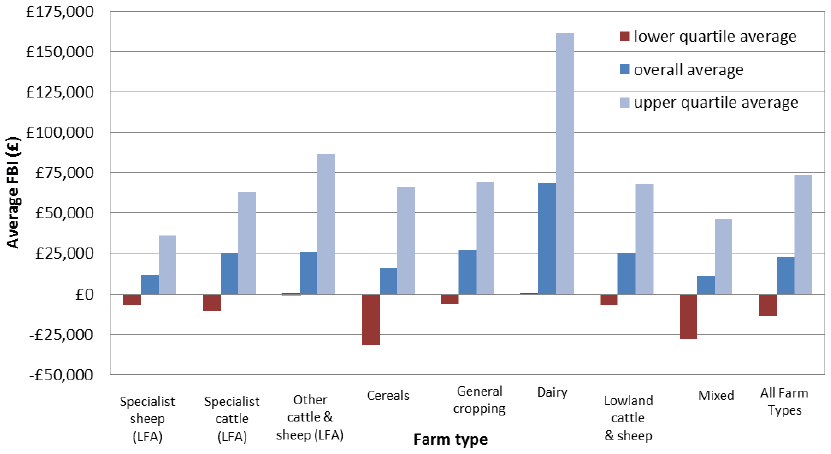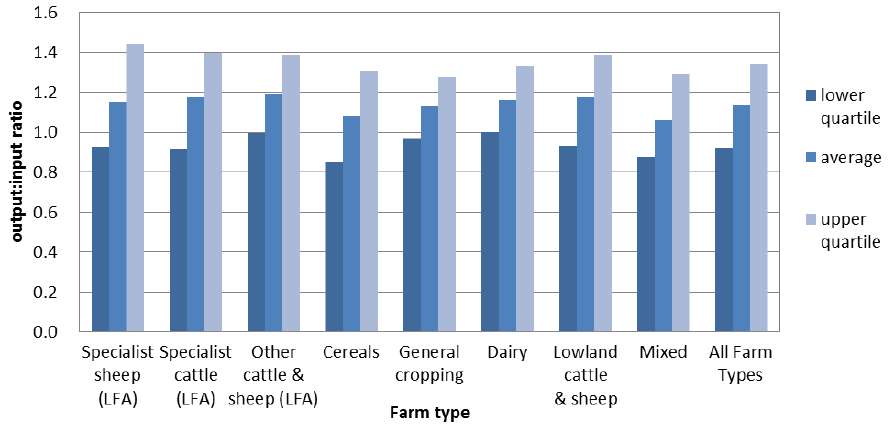Economic Report on Scottish Agriculture, 2016
Presents an overall picture of Scottish agriculture using data from the various agricultural surveys that RESAS manage.
3.4 Income distributions (Tables B4, B8)
Chart 3.6: FBI distribution 2014-15

Chart 3.6 shows the distribution of Farm Business Incomes. Twenty two per cent of farms, or approximately one in five, had a negative FBI. A further 45 per cent had an FBI below £30,000; so, while the average FBI is £31,000, 69 per cent of farms earn less than this. Sixteen per cent of farms achieved an FBI between £30,000 and £50,000. A further 10 per cent achieved an FBI of £50,000 to £100,000, and seven per cent achieved an FBI of £100,000 or more.
Chart 3.7 shows the average FBI of all farm types by quartile, i.e. the average for farm businesses with the lowest 25 per cent of FBI values in each sector, the overall average, and the average of those farm businesses with the highest 25 per cent of FBI values.
Chart 3.7: Average FBI by farm type and quartile (lowest 25 per cent, average, upper 25 per cent), 2014-15

Across all farm types there was a considerable difference between higher and lower performing businesses. The overall average FBI of farms in the lower quartile was a loss of £14,000, while those in the upper quartile generated an average income of £74,000 (more than three times the average FBI).
All lower quartile farms, with the exception of dairy farms (which broke even on average) made an overall loss in terms of FBI in 2014-15. The average FBI of lower quartile farms ranged from a loss of £300 for other cattle & sheep ( LFA) farms to a loss of £32,600 for cereal farms.
Dairy farms had the highest average farm business income in the survey, at £68,000 in 2014-15.
The average FBI for upper quartile farms ranged from two to four times the overall average for each farm type. Dairy farms had the highest upper quartile income at £161,000. Other cattle & sheep ( LFA) farms had the second highest upper quartile income.
There are many factors which contribute to the relative performance of a farm business, including tenure of the farm (with tenant farms having relatively higher overheads), prices and duration of contract for produce, supply costs and efficiency of application of inputs, level of indebtedness, as well as the motivations for farming and preferences for methods of farming of individual farm owners/managers. The variation seen between the quartiles does not take into account the overall size of farms. Larger farm businesses will have larger input costs as well as output value compared to smaller equivalent businesses, but both could be working with equal efficiency.
The output to input ratio can be viewed as a measure of productivity, i.e. how much output can be produced per unit of input. Chart 3.8 shows the differences in the relationship between output value and input costs which result in the differences in FBI. The overall average output to input ratio is 1.14, meaning that for every £1 spent on inputs, Scottish farm businesses are generating £1.14 worth of outputs.
Chart 3.8: Average output:input ratio by farm type and quartile (lowest 25 per cent, average, upper 25 per cent), 2014-15

The average for farms in the upper quartile (relatively high performers) is around £1.34, while for those in the lower quartile (relatively low performers) it is around £0.92; an average loss of £0.08 for every £1 spent. The quartiles here have been determined based on FBI, not on output to input ratio.
It should be noted, however, that a higher output to input ratio does not necessarily lead to a higher FBI when comparing across farm type. FBI depends on both the ratio between and the absolute levels of outputs and inputs. For example, whereas the upper quartile output:input ratio of specialist sheep ( LFA) farms, £1.44, was the highest of all farm types, the upper quartile of specialist sheep ( LFA) farms, £36,000, was the lowest of all farm types. This was due to the relatively low absolute value of outputs and inputs.
Contact
There is a problem
Thanks for your feedback